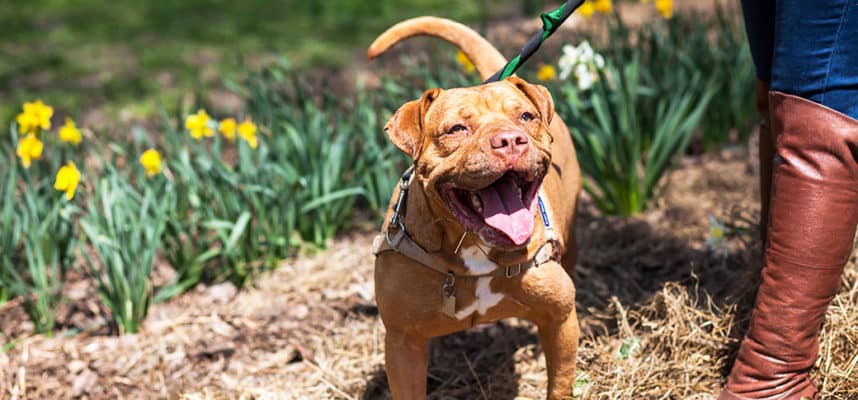
Avoid springtime dangers to your pets

Each change of season presents safety hazards for your companion animals, and spring is no exception.
In fact, the beautiful weather you and your pet enjoy after the cold winter months and before the heat of summer can cause you to throw caution to the wind as you race outdoors to soak up the sun and fresh air.
I encourage you to slow down just long enough to insure your beloved pet doesn’t become victim to a springtime menace.
Indoor Springtime Hazards
- Easter candy and decorations. Even though Easter has passed already this year, you may have a number of things Easter-related stilly lying around your house that can pose a danger to your pet. Chocolate is toxic to dogs, cats and other furry pets. Symptoms of chocolate toxicity include restlessness, panting, increased urination, muscle spasms, vomiting and diarrhea.
And while chocolate is the most toxic candy, you should keep your dog or cat away from all types of Easter goodies, including sweet-smelling candy wrappers.
Lilies can be fatal if eaten by your pet.
The plastic grass used to line your children’s Easter baskets can cause serious gastrointestinal illness for curious kitties. You should also keep ribbons, bows and other colorful enticements out of the reach of your pets.
- Unintended access to the outdoors. Before you throw open your windows and doors to those warm spring breezes, make sure all your screens are in place and that they are in good shape and well-secured.
Cats, in particular, are prone to escaping the house through either an unscreened window or by pushing through a damaged or unsecured screen.
- Spring cleaning chemicals. If you use chemical cleaning supplies around your home, be sure to keep them out of reach of your pet. Commercial cleaning products, almost without exception, contain chemicals that are toxic to your dog or cat, so make sure to follow label instructions carefully and store products securely away from your pet.
Better yet, why not make this the year you switch to non-toxic household cleaning supplies?
- Home improvement hazards. If you’re planning a renovation project around your home or yard this year, keep in mind that many of the chemicals and supplies you’ll need can be dangerous for your pet.
Paints and solvents can be toxic, and building supplies like nails, insulation and certain tools can also pose risks. Read the labels on all products you plan to use to see if they’re safe for pets.
The very best way to keep your dog or cat out of harm’s way is to confine them to an area of your home well away from the project area.
Outdoor Dangers to Watch For in Warmer Weather
- Seasonal allergies. Just like you, your furry companion can have allergies to the plants and pollens of springtime. And a serious allergy in your pet is nothing to sneeze at, as your dog or cat could have a potentially fatal reaction known as anaphylactic shock.
If you suspect your pet is suffering from springtime allergies, you should make an appointment with your veterinarian.
- Yard and garden hazards. The insecticides, herbicides, pesticides and fertilizers many people apply in the spring to bring their lawns and gardens back to life are full of chemicals that are dangerous for pets.
Take care not to allow your dog or cat access to areas of your property where chemicals have been applied, and be sure to store all potentially toxic products out of reach.
- Pretty poisons. Before you stock up on seeds or visit your local nursery, make sure you know which plants, flowers and greenery are toxic to your pet if ingested.
- Warm weather parasites. Work with a holistic veterinarian in your area to decide what kinds of parasite preventives your pets need to keep them free of fleas, ticks, heartworm and other parasites throughout the spring and summer months.
- Driving dangers. As much as your pup may love the feel of the wind on his face, it’s not a good idea to allow him to stick his head out the window of your moving car. And it’s an even worse idea to put your pet in the bed of a pick-up truck for traveling.
Your dog can be hit by debris and even bugs that can cause eye, ear and lung injuries. And there’s simply no guarantee a dog riding in the bed of a truck or by an open car window will not either jump out of the vehicle while it’s moving, or be thrown out during a quick stop or sharp turn.
You should always crate your dog or cat for a ride in the car, or alternatively, use a pet seatbelt harness.
- Exercise injuries. If your dog has been inactive during the winter months, be sure to start slow and help him rebuild muscle tone before he’s allowed to engage in strenuous outdoor activities.This will prevent your pup from developing the too-much, too-soon type of exercise related injuries I see so often at my animal clinic as the weather starts to warm up.
Taking a few precautionary steps and exercising common sense can insure a healthy, enjoyable spring and summer for you and your furry buddy.
If you suspect your pet may have come in contact with a potentially poisonous substance, contact your local veterinarian or the ASPCA Animal Poison Control Center at (888) 426-4435.

